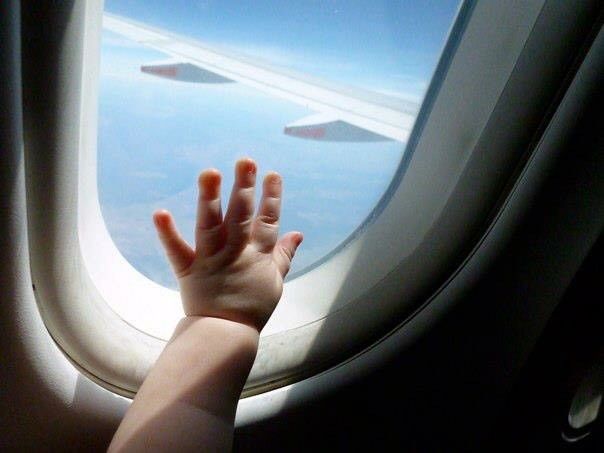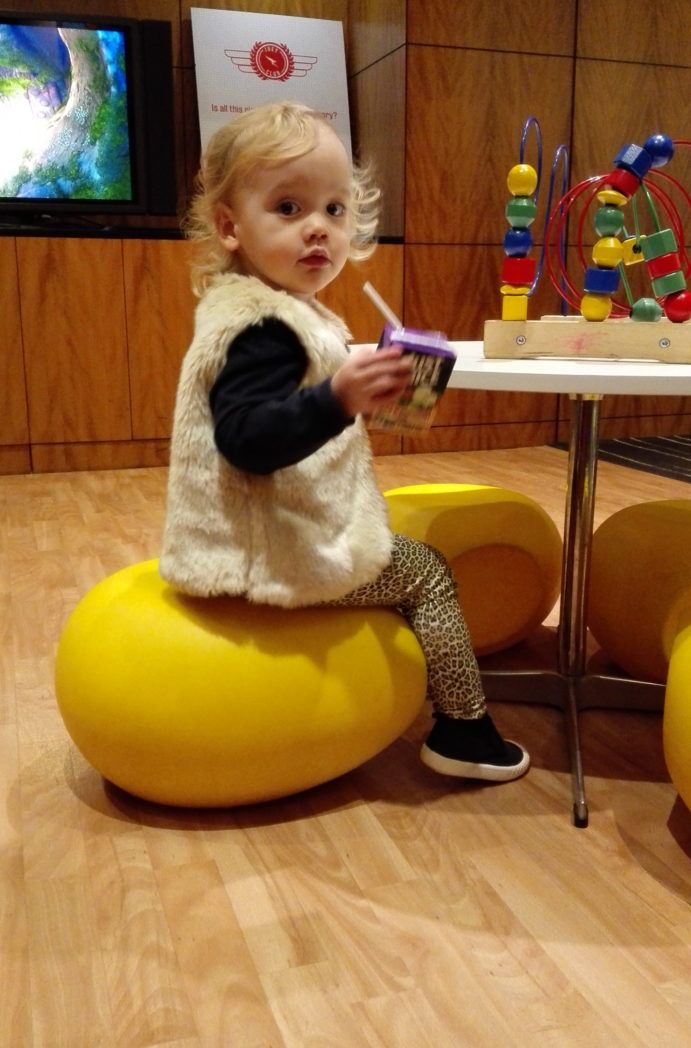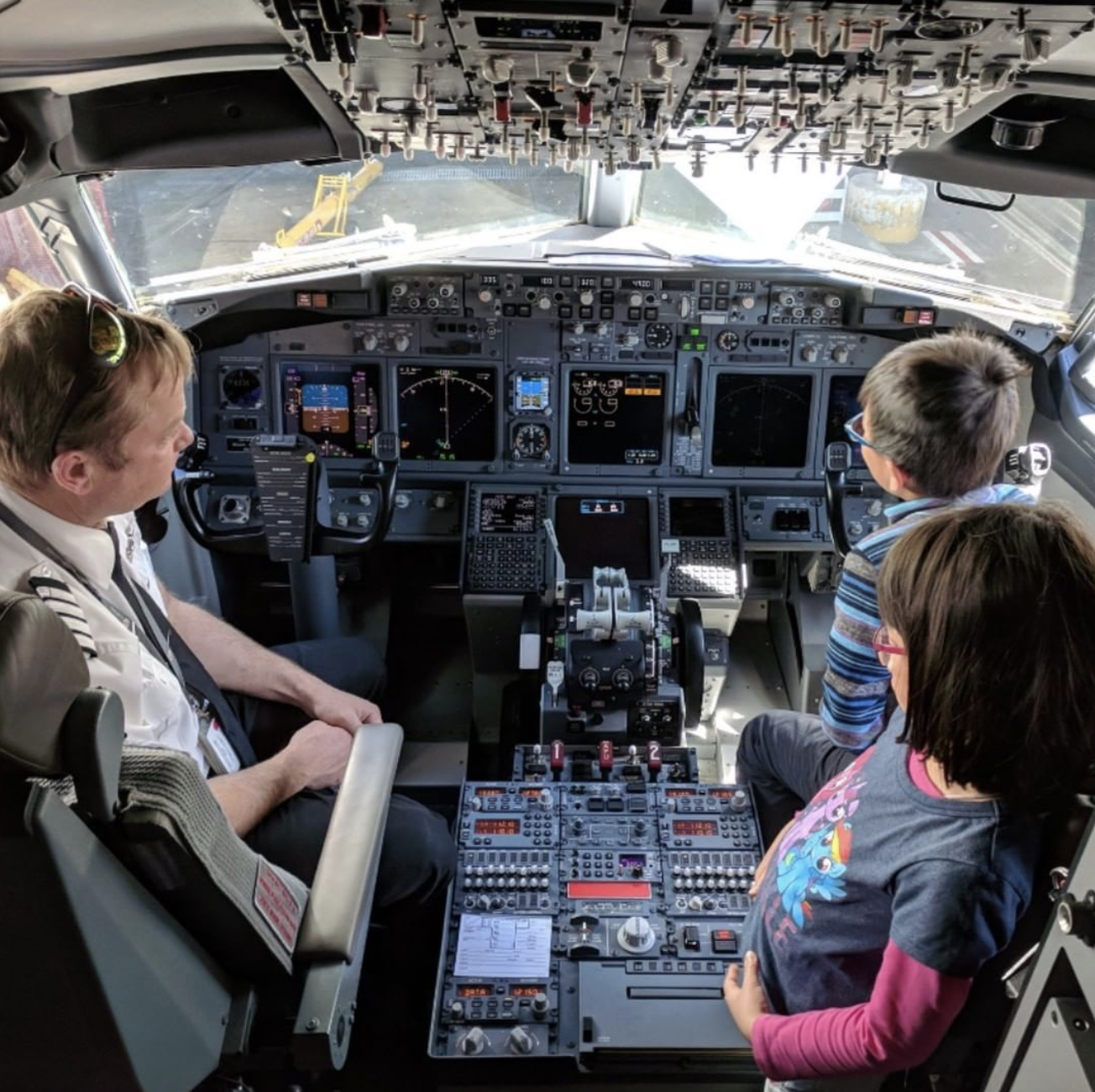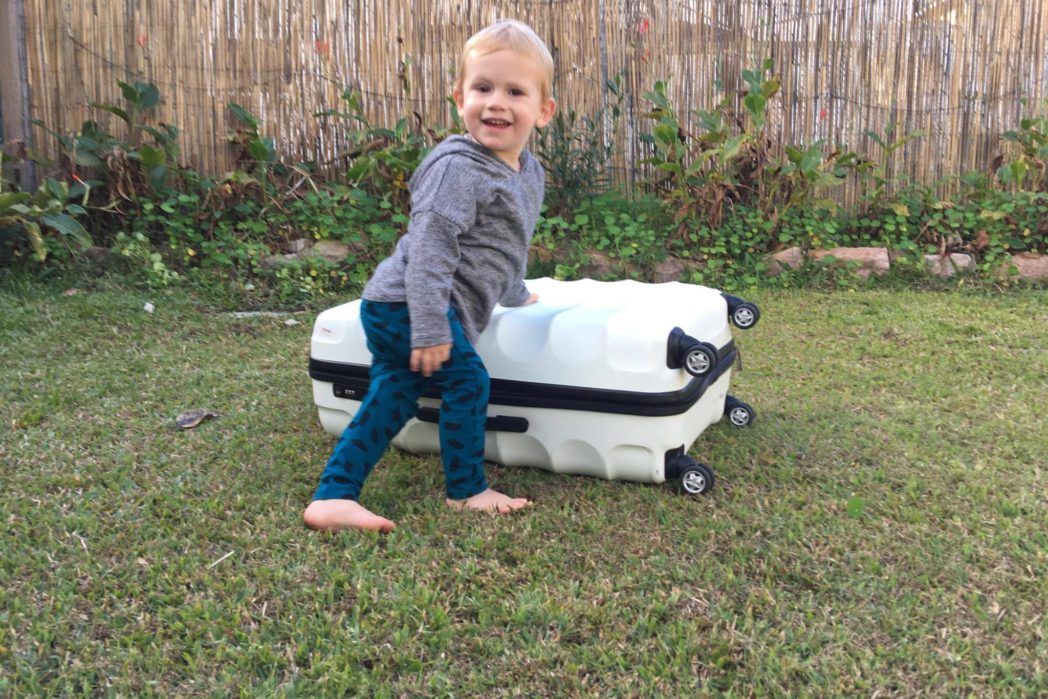Flying with a baby: advanced distraction techniques for little people in confined spaces
Guide

By Sarah Mattsson
In your next microbreak between feeding, nappy changes and attempting to get your little one to sleep, think back to life, pre-baby. You were a jet-setting, wanderlust-oozing free spirit, with a passport so rammed, you were a borderline social media influencer (to your nearest and dearest at the very least).
Just because you now have a bub in tow, doesn’t mean you have to travel on someone else’s Instagram feed.
Be brave and book that holiday further afield than a comfortable road trip. Dust off the suitcase (then buy a cute baby suitcase) and take off on a flight once again.
Flying with a baby can be slightly scary, but we’ve got enough tips, tricks and products to share to help you and your bub become flying experts soon enough.
Flying with a baby 101: Things to consider when booking your flight

Don't be afraid, it's only Brisbane Airport | Photo by Julia Pavey
Most airlines class a child under two as a baby, so you can keep things cosy and share your seat with your mini-me. Between the ages of two to 12, you'll need to purchase an additional child seat. By that stage, you'll be happy to have your own space. Always check with the airline before buying your seats in case there are different rules.
Consider non-stop flights when flying with a baby so there’s only ear popping on one ascent and descent. Babies and small children will struggle with how to manage the changes in pressure. There’s also less fuss and stress moving between flights and entertaining your family for longer stopovers.
If you're considering a break in between long flights, go for a layover rather than waiting in the airport for a long connection. Your baby will have a chance to have a decent sleep and be ready for round two of the flight.
If you have to stick to a connection in between flights, try to allow at least an hour in between arriving and departing on the new flight. Everything always takes longer with little people (especially in a new environment when they’re likely to be tired and overwhelmed).
If you have the option, avoid travelling during peak flying times like Friday afternoons after 5pm, Sunday afternoons and Monday mornings. The emptier the flight, the more likely you’ll be able to spread your family out along a row. Ahhhh, the serenity.
Select your seats like a boss

First sight of the Great Barrier Reef from the air | Photo by @kels
There’s a colossal tug of war debate for and against different seat location recommendations for families. For shorter flights, if you're able to select your seats, aim for a window seat for you and your little one as they'll love to check out what’s happening outside.
For long-haul or overnight flights, you might be better off with the exit-row seats. On larger planes, you’ll have the option of a bassinet, which is better for quality sleep for babies. It means you can get up and not have to have a baby attached to you during the whole flight. Having said that, many parents who opt for these seats and begin with their child in the bassinet end up having more luck with sleeping bubs on their chest or in a baby harness. It's all about going with the flow when flying with a baby. Exit rows are not great for holding carry-on luggage, so keep that in mind too.
Airlines do their best to seat families together so make sure you contact your airline before the day you fly to check.
Getting to the airport with your plus one (or more!)

Workshops Rail Museum, Ipswich
Depending on how long you're travelling for, there are loads of options for getting to the airport. In major cities, save your dollars if you have time (and energy to wrangle little people) and take public transport. The kids will love the excitement of the train or bus.
You can get taxis and Ubers with cars seats as well. It’s best to call ahead to ensure its availability, though (especially for super early or late flights).
If you're only travelling for a few days, it might be easier to drive in and park your car in the medium or long-term airport car parks. From a cost point of view, this might even be cheaper than the taxi or Uber option.
Don’t forget to sign-up for flight alerts so you’ll know if your flight has been delayed or your departure gate has been changed.
Airport tips (before flying with a baby)

Qantas Club Lounge, Brisbane Airport | Photo by
If you want to avoid a full-blown Home Alone airport incident, allow a bit more fat in your usual pre-flight schedule. Things always take longer when you have a toddler to wrangle through a busy airport. Add 10 or 20 minutes to your planning if you're flying with any oversized items like a pram, car seat or portacot.
Most airlines don't charge for these bulky baby-related items, but check when you book or before you arrive with your trolley load at the oversized baggage area.
Get ahead of the pack and check-in ahead of time. Most airlines offer online check-in 24 hours out from your flight time. Save that boarding pass on your phone for quick access so you can whizz through the airport like a boss.
Your little one will be mesmerised (and possibly scared) by the hecticness of the airport so make sure you explain what's happening as you check-in, go through security and check out the departure gates.
With the larger packing list, it's easy to lose track of the regular flying rules. Keep the usual 100ml liquid and gel rules in mind when you’re doing your final check through your carry-on bags. Also, check with the airport and airline around specific inclusions for your destination and flight.
Don’t forget your toddler’s passport for international flights. If you’re keeping your trip local, you will only need to bring along one piece of ID for your little one, like a Medicare card.
If you’re a regular at the airline lounges, check whether they're kid-friendly. Usually, lounges have a kids play area and some food options the little ones will love. This is a great option for keeping your kids busy in the lead up to sitting down for a long period of time. If you can, do it!
Prams vs carriers at the airport

Photo by @stelstar
If you're travelling solo with your baby or toddler, it’s probably best to go with a baby carrier. That way you can lug your little one around the airport and have your hands free to entertain, find important documents and otherwise distract them. Baby carriers also come in handy when you’re on the flight to settle them. Remember to check the rules and regulations with your airline before you board.
If you're going to take your pram on holidays and you have someone to help hoon through to the departure lounge, see if you can keep your pram with you up until the gate. A few mums and dads have suggested the Quinny Yezz as a great lightweight, foldable (even wearable as a backpack) option.
Some airlines request that you check your pram in before going through security, but will usually supply an airline version for use throughout the airport. Prams are also a godsend if your little one has outgrown the baby carrier. No one with a family has time for an indulgent massage at the airport to fix a sore back.
Don’t forget, in most cases, you can hire a pram and other baby essentials (porta cot, high chair and even activity centres) on the other end. The extra cost might be well worth the convenience.
What to pack when flying with a baby

Photo by @katieanstiss
For babies, double up – we're talking a large nappy bag and a smaller bag inside. This might sound over the top, but the smaller bag of goodies helps so you can keep your must-haves closeby (and accessible from your seat if your child snoozes on you) rather than out of reach in the overhead luggage compartment. Also, when you change a nappy you only need to take a small clutch or bag to the mini-aeroplane toilets.
If you’re flying with a toddler, pack a small backpack for your toddler to carry. Trunkis are another helpful option so your child can sit out the wait times on their bags during transit.
Fill that nappy bag up with all the important stuff:
- Nappies and wipes (definitely include more than you’d normally need for the flight time) and any special creams. Spare underwear if they're toilet training.
- Spare clothes (yup, for both you and your child).
- Blankets to keep them rugged up.
- Snuggle friend and dummies (don’t forget some spares!) and dummy clips.
- A few small books and soft toys to keep them entertained.
- Baby change table cover.
- Muslim wraps to help reduce light while they sleep and to cover-up if you’re breastfeeding.
- Sippy cup or bottles with formula or breast milk. Check with your airline for advice on travelling with breast milk and consider how you will keep your bottles at the ideal temperature during the flight.
- Books and toys to keep them comforted and entertained. Tegu’s original pocket pouch is magnetic which keeps all the individual parts together. ‘A Day at the Animal Airport’ is a great book for newbie flyers, too.
- Age appropriate travel games, play dough, pencils and colouring-in books or stickers.
- Favourite snacks and drinks (consider containers that reduce mid-flight spillages).
- Kid-friendly volume-limiting headphones and headphone splitter so you can catch-up on your fave kids movie or TV show or music. Make sure you can still access your child’s go-to audio (white noise or soft lullabies) to help your baby off to sleep.
- Ziplock bags.
- Kid-sized travel pillow or neck rest.
- More baby wipes
PS. Some parents say these products are a little over the top, but if you’re a frequent-flying family, they might be helpful:
- Fly Legs Up. If you're going long distances, try this seat hammock with inflatable pillows. When your toddler needs a nap, they can sleep on a flat surface and keep their seatbelt on too. If they want to play, there’s room for their toys so you don’t have to pick them up off the ground every two seconds.
- Fly Tot. Another option to increase your kid’s comfort level. The Fly Tot is a small inflatable cushion that helps toddlers sitting in their own chairs on a flight get comfortable.
- Snack and Play Travel Tray. For kids sitting in a seat, it’s hard for them to reach the normal tray table for their food and entertainment needs. Packing a travel tray is helpful for the plane and it can be used throughout the holiday when you attach it to a car seat or for meals out and about.
- Bassinet to go. If you can’t get the exit row and bassinet combo, BYO travel bassinet for your baby and position it on your legs during the flight.
- Bagrider. Another option for parents who don't want to scoot around the airport with a pram or baby carrier is a bagrider that transforms your regular carry on suitcase into a travelling seat for toddlers up to 15kg.
PS. Virgin Australia has just announced changes to their policies and little people are now allowed certain comfort devices on board.

Photo by @virginaustralia
And, take-off! Tips for the flight
There’s no prize for rushing onto the plane first, especially when you're flying with a baby. Avoid the crowded boarding line and run your tike around the departure gate area to tire them out. Most airlines have a special time for family boarding - listen out during the boarding process.
As you get settled onboard, introduce yourself and your child to the flight attendant in your area as they can be very helpful with special requests during the flight. Bring on the hours of peekaboo!
Try to keep their nap and feeding times similar to their regular schedule during the flight. It’s a good idea to ensure your little person is sucking on something during take-off and landing to help with potential ear pain so keep their sippy cup, chewy treats or dummies handy.
Keep bub up-to-date and explain what's happening during the flight to calm them down during potentially scary situations like seat belt and turbulence alerts, updates from the crew and turbulence.
During the actual flight, it’s all about distraction. New books and new toys work a treat. But don’t forget their one favourite toy or book as well to give a little taste of their regular life.
Things to consider when packing

Generally, if your child is under two and you aren’t buying them a separate seat, their luggage allowance will be part of your baggage allowance.
If you do have a separate allowance for your child, it’s a lot easier to bring most of their favourite items in their own suitcase or bag.
Hopefully, this little cheat sheet has helped with a few tips before your first time flying with a baby. Before you book, check out these tips for how to travel with a baby or a toddler. You’re welcome.
It's time to book! Now, where should you go?

Hamilton Island, The Whitsundays | Photo by Blonde Nomads
If you're looking for inspiration for your first flight with your baby, try these family-friendly locations:
- Hamilton Island: Fly into an island set-up for family-friendly vacays with direct flights from Sydney, Melbourne, Brisbane and Cairns. For homework, read up on our family guide to the Whitsundays and a 48-hour guide to Hamilton Island.
- Gold Coast: Get ready for a beachside break on the Gold Coast with direct flights from Sydney, Melbourne, Perth, Adelaide, Cairns, Townsville and international cities in New Zealand, Asia and Europe. We've got you sorted for kid-friendly ideas on the Gold Coast and a guide to the Gold Coast's theme parks, too.
- Cairns: It's never too early for a first trip to the Great Barrier Reef! Fly to Cairns Airport from Sydney, Melbourne, Brisbane, Gold Coast, Adelaide, Perth, Darwin and international hot spots like Asia and New Zealand. Get easy access to the reef with a day trip or ferry to a family-friendly oasis like Green Island or Fitzroy Island. Nemo, pools and kids' club, yes please! For more kid-friendly ideas around Cairns, check out something we prepared earlier.
- Brisbane: Fly into Queensland's capital from Sydney, Melbourne and loads of big and small towns in Australia. The Brisbane International Airport takes the most amount of international arrivals of any Queensland Airport, too. Before you fly into the big smoke, get excited about your trip with our best things to do in Brisbane with kids wrap-up or get some ideas on how to include a bit of me time into your holiday.
PS. If all else fails, just check in with legendary How to Dad. He's got all the tips you'll need.
